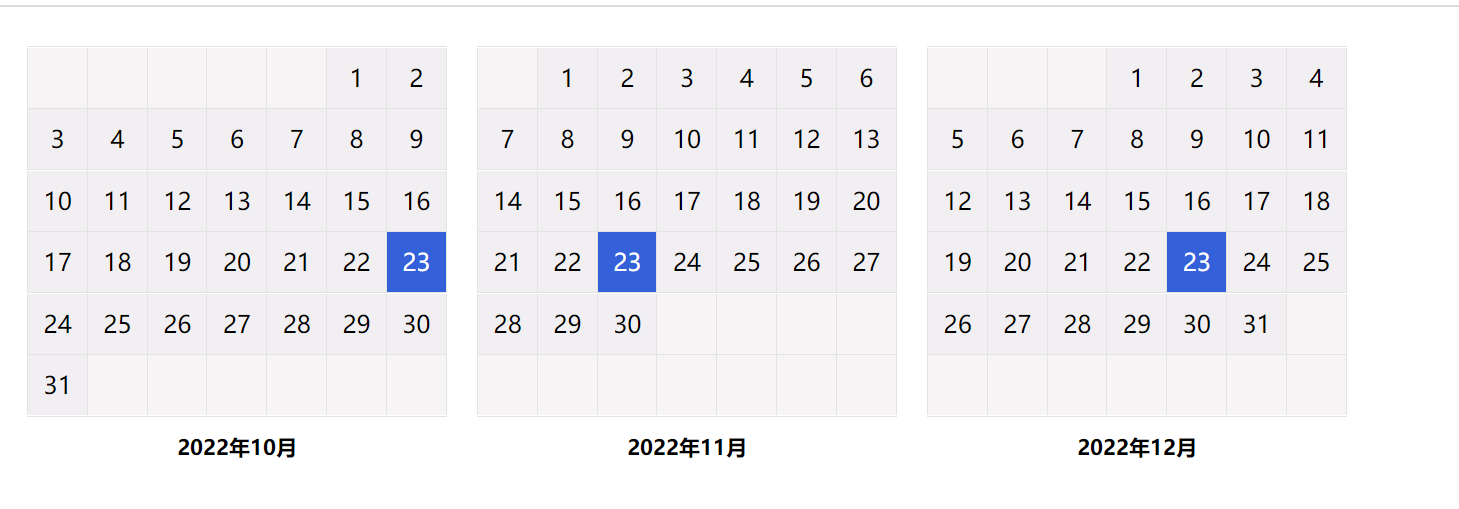实现一个日历图的一个展示图
TIP
本文主要是实现一个日历月份的展示,支持高亮某些日子(当月的可以是多个)。展示效果如下图:

实现细节
- 区分每个月份几天(1-12),需要特俗处理2月份区分是不是闰月,其他月写个map映射下就好了。
- 每个月画6行7列进行展示
- 需要找每个月的开始绘制日期(比如10月1号是周5,那咱们就要在第一行的第五个开始绘制文本)。
vue 实现逻辑
TIP
源码实现如下 关键判断((row * 7) + (column + 1) >= startDay) && (row * 7) + (column + 1) < startDay + countDay 解读:限制最小开始日期 && 限制最大日期
vue
<!-- calendar-chart.vue -->
<template>
<div class="calendar-container">
<div class="calendar-container-header">
<slot name="header" />
</div>
<div class="calendar-container-body">
<div
v-for="row in [0,1,2,3,4,5]"
:key="`row-${row}`"
class="calendar-row"
>
<div
v-for="column in [0,1,2,3,4,5,6]"
:key="`column-${column}`"
class="calendar-column"
:class="[
{'is-action': actionDate.includes((row * 7) + (column + 1) - (startDay - 1))},
{'is-have': ((row * 7) + (column + 1) >= startDay) && (row * 7) + (column + 1) < startDay + countDay}
]"
>
<span v-if="((row * 7) + (column + 1) >= startDay) && (row * 7) + (column + 1) < startDay + countDay">
{{ (row * 7) + (column + 1) - (startDay - 1) }}
</span>
</div>
</div>
</div>
<div class="calendar-container-footer">
{{ footerValue }}
</div>
</div>
</template>
<script>
import {
MONTH_MAP, getCurrentMonth, getFebruaryDay, getStartDay, getDate, getFullYear,
} from './utils';
export default {
name: 'CalendarChart',
props: {
date: {
type: Array,
required: true,
default: () => ['2021.10.23'],
},
},
computed: {
startDay() {
return getStartDay(this.date[0]); // 用月份找到1号的开始值
},
countDay() { // 每个月的总共时间
return MONTH_MAP[getCurrentMonth(this.date[0])] || getFebruaryDay(this.date[0]);
},
actionDate() { // 计算要高亮的天
return this.date.map((item) => getDate(item));
},
footerValue() { // title
return `${getFullYear(this.date[0])}年${getCurrentMonth(this.date[0])}月`;
},
},
};
</script>
<style lang="scss" scoped>
%flex-base {
display: flex;
flex-direction: row;
flex-wrap: nowrap;
}
.calendar-container {
display: inline-block;
width: 280px;
margin: 10px;
.calendar-container-body {
@extend %flex-base;
flex-direction: column;
.calendar-row {
@extend %flex-base;
border-top: 1px solid #E3E3E3;
.calendar-column {
text-align: center;
width: 40px;
height: 40px;
line-height: 40px;
border-left: 1px solid #E3E3E3;
background-color: #F7F4F5;
&.is-have {
background-color: #F1EFF1;
}
&.is-action {
background-color: #3461DA;
color: #fff;
}
}
>:last-child {
border-right: 1px solid #E3E3E3;
}
&:last-child {
border-bottom: 1px solid #E3E3E3;
}
}
}
.calendar-container-footer {
width: 100%;
height: 40px;
line-height: 40px;
text-align: center;
font-weight: 700;
font-size: 14px;
}
}
</style>js
// utils.js
export const getCurrentWeekDay = (date) => {
const week = new Date(date).getDay();
return week === 0 ? 7 : week;
};
export const getCurrentMonth = (date) => {
const month = new Date(date).getMonth();
return month + 1;
};
export const getFullYear = (date) => new Date(date).getFullYear();
export const isLeapYear = (date) => {
const year = getFullYear(date);
return (year % 4 === 0 && year % 100 !== 0) || year % 400 === 0;
};
export const getFebruaryDay = (date) => (isLeapYear(date) ? 29 : 28);
export const getDate = (date) => new Date(date).getDate();
export const getStartDay = (date) => {
const formatDate = new Date(date).toLocaleString();
let sum = 0;
let findIndex = -1;
for (let index = 0; index < formatDate.length; index++) {
const element = formatDate[index];
if (element === '/') {
sum += 1;
}
if (sum === 2) {
findIndex = index;
break;
}
}
return getCurrentWeekDay(formatDate.substring(0, findIndex));
};
export const MONTH_MAP = {
1: 31,
3: 31,
5: 31,
7: 31,
8: 31,
10: 31,
12: 31,
4: 30,
6: 30,
9: 30,
11: 30,
};使用方式
TIP
使用组件
vue
<template>
<div>
<calendar-chart :date=['2022.10.23']/>
<calendar-chart :date=['2022.10.23']/>
<calendar-chart :date=['2022.10.23']/>
</div>
</template>
<script>
import CalendarChart from './calendar-chart.vue'
export default {
components: { CalendarChart, }
}
</script>